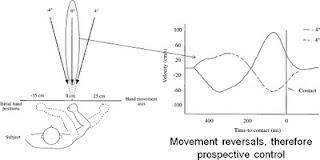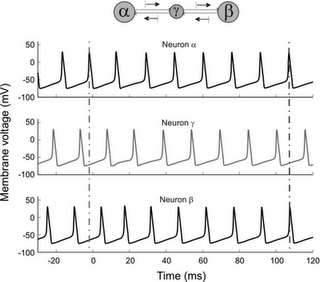It's typically suggested in psychology that these delays are compensated for via computational predictions; the nervous system 'perceives the present' by taking the lagged input and using it as the basis of a guess about what's going on now (e.g. Changizi et al, 2008, plus see this post from a while back). This is a problematic idea: if the perceptual control of actions is based on a guess compensating for a variable time lag, then the stability issue remains, not to mention the consequences for mis-predicting the future. Regardless, it's not really an option for a theory of direct perception, and I want to discuss a couple of options.
Prediction vs. Prospective Control
Prediction is a risky business. Not only is it computationally intensive and time-consuming in and of itself, errors can readily accumulate throughout the process leading to potentially catastrophic failures of the system. The perception-action system is particularly vulnerable to this, as it typically operates in a 'just enough, and just in time' fashion. Recent empirical work has begun investigating the possibility of prospective control. This is a more robust control strategy that entails coupling yourself to currently available information to control action so as to achieve a future goal. Of course, it requires the availability of useful information.
Montagne et al (1999) tested a way to identify which strategy is being used in an interception task. Intercepting a moving object means getting yourself to the right place at the right time. Montagne et al created a simple interception task in which the object to be intercepted started in one of three locations and smoothly moved to a central location.They also varied the initial location of the person's hand, such that it was either at the final location of the target already, or off to one side. If people were predicting, they should simply move their hand to the final location; if they were prospectively coupled to information about the target, they should exhibit movement reversals. (The geometry of the set up meant that the hypothesised information varied over time for certain combinations of initial hand and target location so that using it would make you overshoot and have to correct). They then went looking for (and found) the movement reversal signature, confirming prospective control (see Figure 1).

Figure 1. Movement reversals in interception (Montagne et al, 1999)
Neural architecture and zero-phase lags
Prospective control is showing up in all kinds of perception-action tasks. However the basic problem of neural delays persists: if you couple yourself to an information variable, it still takes time for that information to be available to control action. Perhaps you're still 'perceiving-the-present' but just basing your behavior on a predicted value for the information for prospective control. How problematic are these lags?
It's possible that they aren't actually much of a problem, thanks to an intriguing embodied solution to the problem which I came across as I work through Networks of the Brain (Sporns, 2010). Vicente et al (2008) investigated how you can establish synchronous behavior between widely separated regions of cortex via a simple motif (Milo et al, 2002; see also Sporns, 2010). Motifs are simple patterns of connectivity between nodes of a network; for example, three nodes can be connected in 13 distinct ways, and each of these is a motif. These form a kind of alphabet, from which you can build networks with particular properties. Vicente et al demonstrated that a dual dyad motif promotes self-organisation of the system into synchronous behavior with no lag, even if there are significant conduction delays present between the nodes (see Figure 2). This solution is embodied because the solution doesn't require computation; rather, the system solves the problem by being built in a particular way.

Figure 2. The α and β neurons begin out of sync but with a few spikes remove the phase lag (fFrom Vicente et al, 2008)
Vicente et al demonstrated that this network architecture promotes this type of self-organisation between individual neurons and populations, over a wide range of latencies. The system doesn't entirely eliminate lag, because it still takes time for the synchronised behavior to emerge after a perturbation; however, the time taken for the system to respond is less than the time you get if you just add up the individual conduction times between the neurons. Given that this is how the delays typically cited by people like Changizi et al (2008) are computed, this paper is an important contribution towards identifying ways to compute the actual lags in the system.Reverberation vs. Serial Order
The motif solution is interesting, because it changes the focus a little for the way the problem is posed. Clearly, in a system that actually exhibits conduction delays, you cannot instantly ping one end of a connection and get a zero-phase lag, no delay response at the other end. But the motif solution isn't saying this: the fast self-organisation of synchronous behavior emerges once the system in question is up and running. It takes a finite amount of time for information to zing around the network from the moment you 'switch it on', but once it's going, the network that has been built now reverberates as a whole in response to events in any node. Typically, lag estimates are computed by just adding up the conduction times for all the neurons involved in a linear, serial event; for responding to stimulation on your toe, for instance, you add up the conduction times for the long axons that synapse in the spinal cord and the axons that connect from the spine to cortex (plus time for the slower chemical transmission process at each synapse). Same for the supposed lag between the eye and visual cortex.
The analogy that came to mind is what happens when you switch a light bulb on in a dark room. Light leaves the bulb and streams out in all directions; it travels until it hits a surface, when it is reflected according to the relevant laws. Eventually, some of this light passes through the point in the room occupied by your eye; light at this point of observation comes from all over the room (and hence you can see all over the room) and continually flows through that point. The room is entirely filled but only after a measurable amount of time; it seems instantaneous because light travels so fast.
Once the room is filled, you can simply move through this optic array and the light you sample smoothly alters in response. Critically, light from objects at different distances behaves appropriately; even though the light had to travel different distances and therefore took different times, there is no lag - objects further away don't take longer to 'update' a given point of observation. Why? Because once the room is filled, the light coming from those two surfaces has already covered the distances to the point of observation and is simply being replaced with a continuous stream of light that's done the same. The lag problem has been solved because it happened during the time when the room was filling with light.
I think that the motif solution is a bit like this. The lags the motif is fixing exist, but only until the system is up and running. Once the system is going, information continually flows through, say, a given point of observation and the structure at that point implements the lag correction already. Perception, action and cognition are continuous and are built to take advantage of what that continuity affords.
Summary
Lags and delays in the system are typically a problem which is solved computationally, via internal models which take an input at time t-delay and use that input to predict what the input will be at time t. But prediction is a risky business because if your internal model is incorrect, you will have your face eaten by that bear (or something similar). Solving these problems via internal computational models is also not a legal move for the ecological approach, so the question is, how do we solve it? What else might it be?
In behavioural studies, we make the distinction between prediction and prospective control. The latter typically predicts a pattern such as movement reversals, because the control strategy is to be coupled to an information variable (typically a higher order variable that specifies the property of the world you're interested in) and your behavior follows the behavior of that variable over time; a little like the Watts steam governor. People have gone looking for this signature in a variety of interception tasks (typically thought to require prediction); in general, we only see evidence for prospective control (the outfielder problem is another great example of this). There's much more to do here: the eye movement literature, for example, tends to still talk mostly about predictive mechanisms to explain successful tracking behavior. I hope to get into this empirically over the next few years.
Neurally, you can also address the delay issue without resorting to computations that implement prediction. Network motifs are architectural features that shorten effective path lengths and create functionally related clusters; in short, they promote 'small world' architecture (Watts & Strogatz, 1998). Those clusters, or hubs (like the γ node above) are essential to maintain network-wide information flow; however, they work by facilitating flow in the network, and not by implementing special computations:
Their influence derives from their capacity to connect across much of the brain and promote functional integration, not from special intrinsic processing power or capacity for "decision making". Hubs enable and facilitate integrative processes, but they do not represent their outcome, which instead is found in the distributed and global dynamics of the brain.Sporns, 2010, p. 125.As the Watts governor continues to remind us, there are often dynamical solutions to supposedly algorithmic control problems that work via specifically built devices coupled to relevant information, and these solutions don't implement the algorithmic description. This is a different way to think about, for example. the delays and problems the nervous system actually faces, and the resources it has available to address them. These resources aren't computational: they are architectural and informational. They are, in fact, embodied.
References
Changizi, M. A., Hsieh, A., Nijhawan, R., Kanai, R., & Shimojo, S. (2008). Perceiving-the-present and a systematization of illusions. Cognitive Science, 32(3), 459-503. DOI Download
Montagne, G., Durey, A., Bootsma, R., & Laurent, M. (1999). Movement reversals in ball catching Experimental Brain Research, 129 (1), 87-92 DOI: 10.1007/s002210050939 Download
Sporns, O. (2010) Networks of the Brain. Cambridge, MA: MIT Press. Amazon.co.uk
Vicente, R., Gollo, L., Mirasso, C., Fischer, I., & Pipa, G. (2008). Dynamical relaying can yield zero time lag neuronal synchrony despite long conduction delays Proceedings of the National Academy of Sciences, 105 (44), 17157-17162 DOI: 10.1073/pnas.0809353105 Download
Watts, D.J. & Strogatz, S. H. (1998). Collective dynamics of "small-world" networks. Nature, 393, 440-442. DOI Download

